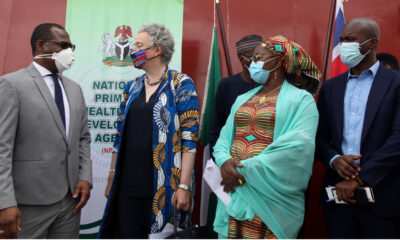Agriculture
Acute Food Insecurity Soars to Five-year High, Warns Global Report.

Conflict, economic shocks – including due to COVID-19, extreme weather – pushed at least 155 million people into acute food insecurity in 2020. The number of people facing acute food insecurity and needing urgent life and livelihood-saving assistance has hit a five-year high in 2020 in countries beset by food crises, an annual report launched today by the Global Network Against Food Crises (GNAFC) – an international alliance of the UN, the EU, governmental and non-governmental agencies working to tackle food crises together – has found.
The stark warning from the 2021 Global Report on Food Crises reveals that conflict, or economic shocks that are often related to COVID-19 along with extreme weather, are continuing to push millions of people into acute food insecurity.
The Global Network Against Food Crises report reveals that at least 155 million people experienced acute food insecurity at Crisis or worse levels (IPC/CH Phase 3-5) across 55 countries/territories in 2020 – an increase of around 20 million people from the previous year, and raises a stark warning about a worrisome trend: acute food insecurity has kept up its relentless rise since 2017 – the first edition of the report.
Of these, around 133 000 people were classified in the most severe phase of acute food insecurity in 2020 – Catastrophe (IPC/CH Phase 5) – in Burkina Faso, South Sudan and Yemen where urgent action was needed to avert widespread death and a collapse of livelihoods.
At least another 28 million people faced Emergency (IPC/CH Phase 4) level of acute food insecurity in 2020 – meaning they were one step away from starvation – across 38 countries/territories where urgent action saved lives and livelihoods, and prevented famine spreading.
Thirty-nine (39) countries/territories have experienced food crises during the five years that the GNAFC has been publishing its annual report; in these countries/territories, the population affected by high levels of acute food insecurity (IPC/CH Phase 3-5) increased from 94 to 147 million people between 2016 and 2020.
Additionally, in the 55 food-crisis countries/territories covered by the report, over 75 million children under five were stunted (too short) and over 15 million wasted (too thin) in 2020.
Countries in Africa remained disproportionally affected by acute food insecurity. Close to 98 million people facing acute food insecurity in 2020 – or two out of three – were on the African continent. But other parts of the world have also not been spared, with countries including Yemen, Afghanistan, Syria and Haiti among the ten worst food crises last year.
The Key Drivers Behind Rising Acute Food Insecurity in 2020 were:
- Conflict (main driver pushing almost 100 million people into acute food insecurity, up from 77 million in 2019);
- Economic shocks – often due to COVID-19 – replaced weather events as the second driver of acute food insecurity both in terms of numbers of people and countries affected (over 40 million people in 17 countries/territories, up from 24 million and 8countries in 2019); and,
- Weather extremes (over 15 million people, down from 34 million).
While conflict will remain the major driver of food crises in 2021, COVID-19 and related containment measures and weather extremes will continue to exacerbate acute food insecurity in fragile economies.
Statement from the Global Network Against Food Crises:
“One year after the declaration of the COVID-19 pandemic, the outlook for 2021 and beyond is grim. Conflict, pandemic-related restrictions fuelling economic hardship and the persistent threat of adverse weather conditions will likely continue driving food crises,” said the European Union (EU), the Food and Agriculture Organization of the United Nations (FAO), the United Nations World Food Programme (WFP) – founding members of the Global Network – together with USAID in a joint statement released with the report.
“The COVID-19 pandemic has revealed the fragility of the global food system and the need for more equitable, sustainable and resilient systems to nutritiously and consistently feed 8.5 billion people by 2030. A radical transformation of our agri-food systems is needed to achieve the Sustainable Development Goals.”
“The protracted nature of most food crises shows that long-term environmental, social and economic trends compounded by increasing conflict and insecurity are eroding the resilience of agri-food systems. If current trends are not reversed, food crises will increase in frequency and severity”.
To address these challenges the Global Network will step up efforts to promote resilient agri-food systems that are socially, environmentally and economically sustainable, and will support major events this year such as the UN Food Systems Summit, the Convention on Biodiversity, the G20 Summit, the Climate Change Conference, and the Nutrition for Growth Summit. It will also cooperate with the G7 initiative to avert famine.
The Global Network emphasises the need to act urgently and decisively, and calls for the international community to mobilise against hunger.

















